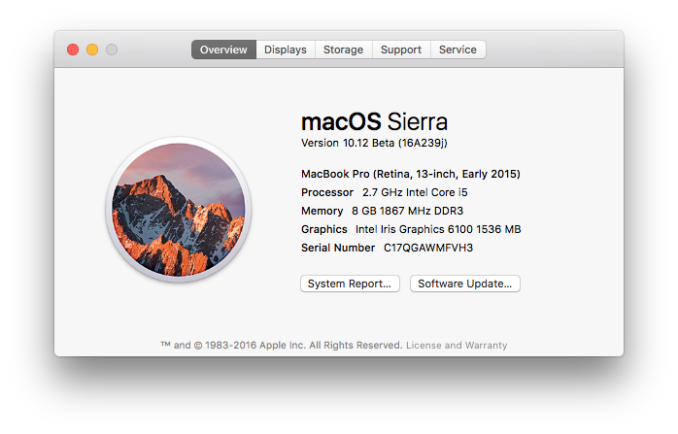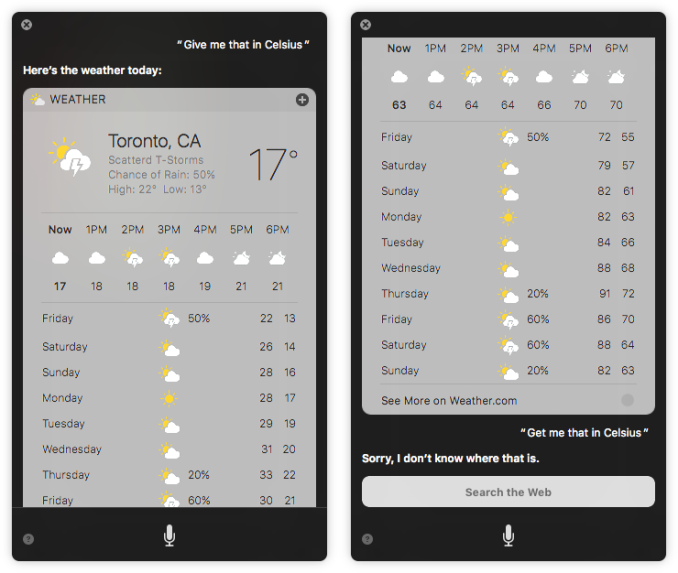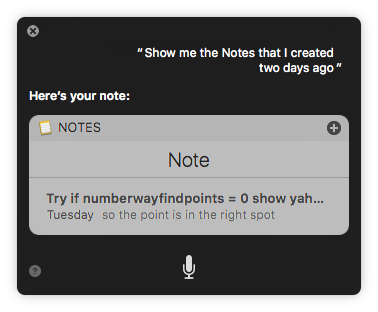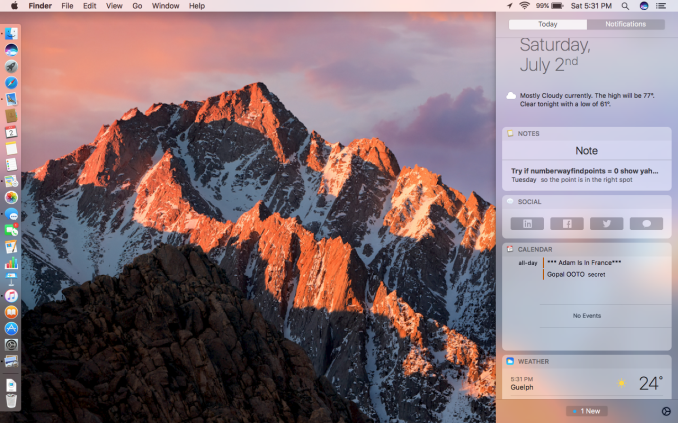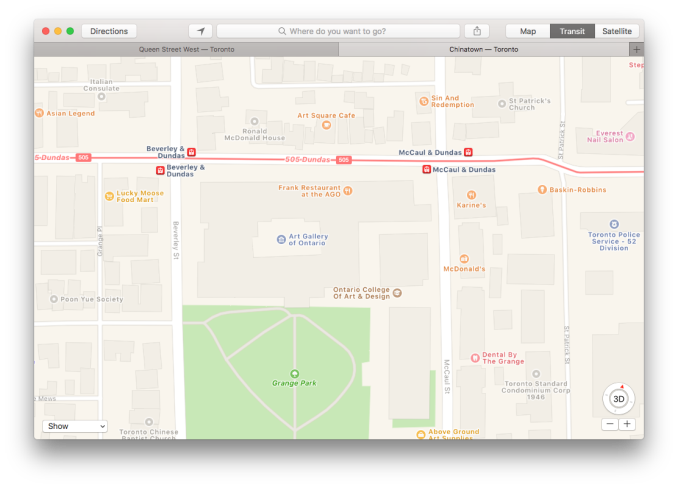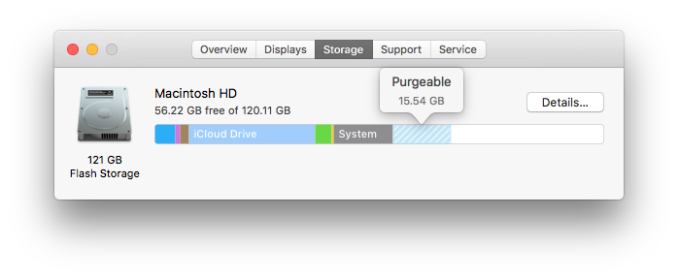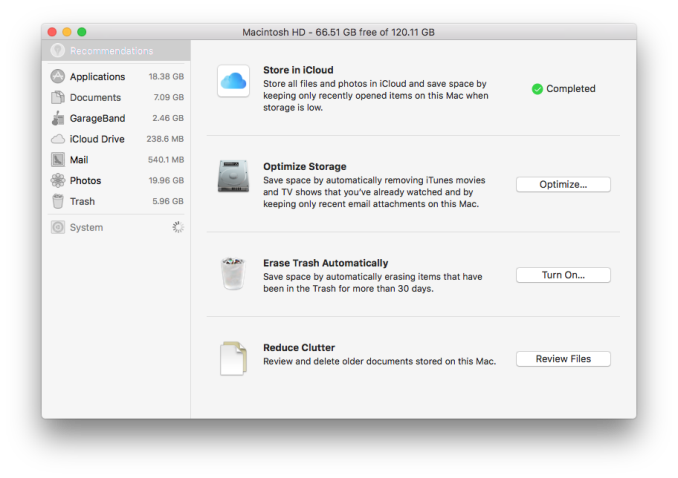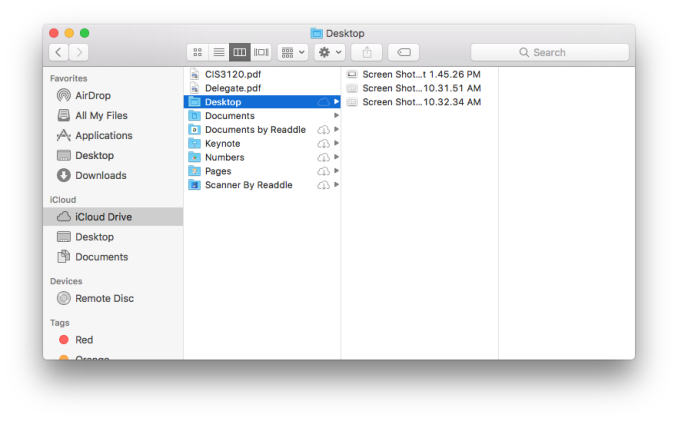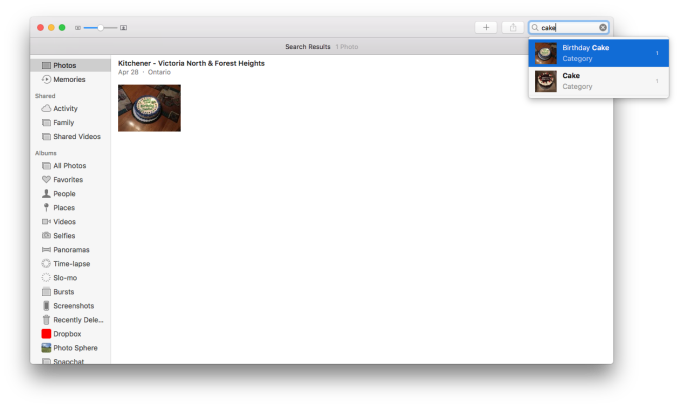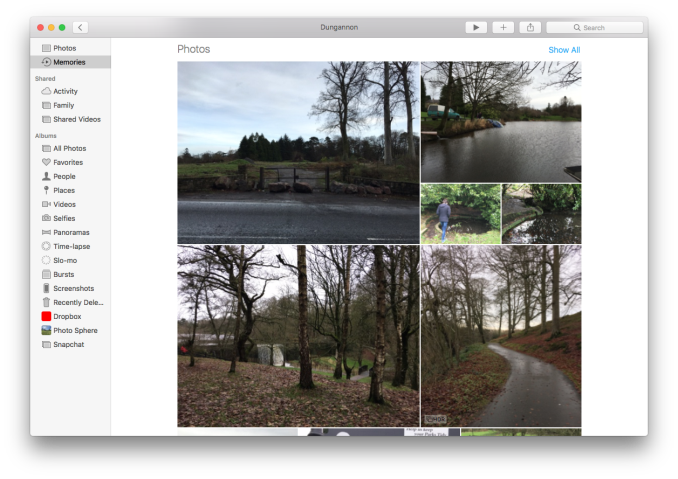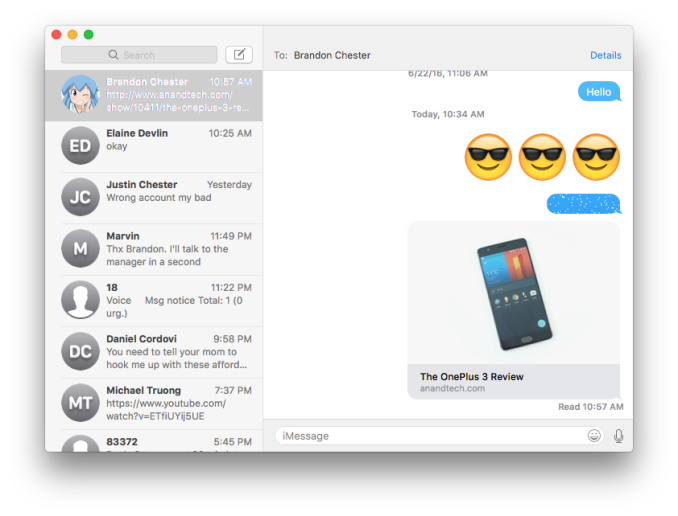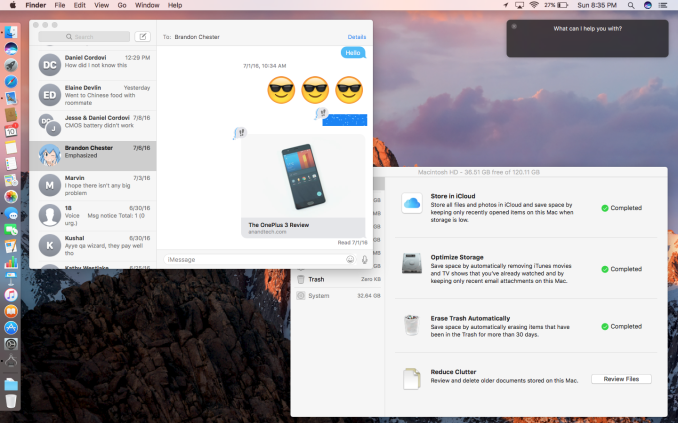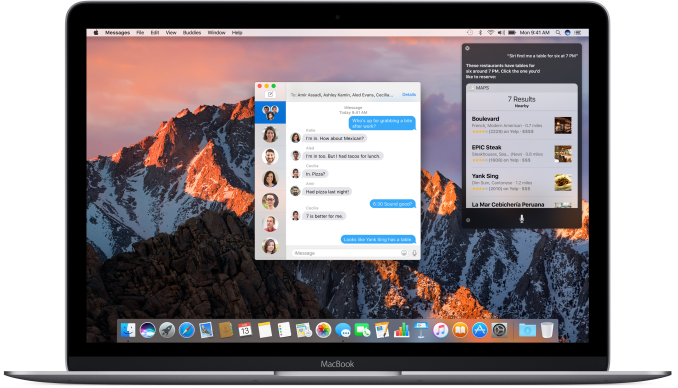
As with past years, Apple’s WWDC 2016 keynote showcased the upcoming updates to Apple’s operating systems and developer tools. It’s hard to believe that iOS is now on its tenth major version, which put Apple in an interesting position since their desktop operating system has been called OS X for many years now. Given that Apple’s other operating systems are named iOS, watchOS, and tvOS, the name OS X has become a bit of an outlier. This year’s release comes with a new name in the typical manner that OS X releases each had a specific name, but also a new name for the operating system itself. The 2016 version of Apple’s operating system for Macs is named macOS Sierra.
While macOS adopts a new name, it retains the existing versioning system, with macOS Sierra being version 10.12. This makes sense when you consider the progression from Mac OS 9 to Mac OS X, which then treated each release as a point update on top of ten and only dropped the Mac in the name in 2012. This kind of versioning is somewhat awkward, and will be more so when it gets to the point where the OS is version 10.20. It will be interesting to see if the next truly large update to macOS brings it to major version eleven, and it could be that Apple plans to keep it in sync with iOS with a new major version number each year, but only time will tell.
Like all updates to macOS, Sierra comes with a number of new features. With the bulk of Apple’s device sales being mobile devices, there have been a number of features in recent versions of macOS that work to leverage how devices running macOS, iOS, and watchOS can work together. Having cloud sync across devices is one thing, but building and properly executing Apple’s continuity features really requires control over the hardware and software stacks across all devices. Unfortunately it’s difficult to test these features during Apple’s beta period, but that just gives Apple’s users things to look forward to later in the year.
More important than new features is whether or not a Mac can even be upgraded to macOS Sierra from OS X El Capitan. Apple has announced the compatibility list for Sierra, and there are some older Macs that have dropped off the list. I’ve put together a chart comparing the compatibility of Macs with El Captain and compatibility with Sierra.
| OS X El Capitan | macOS Sierra | |
| MacBook Pro | Mid 2007 and newer | 2010 and newer |
| MacBook Air | Late 2008 and newer | 2010 and newer |
| Old MacBook | Late 2008 aluminum and newer | Late 2009 and newer |
| New MacBook | 2015 and newer | |
| iMac | Mid 2007 and newer | Late 2009 and newer |
| Mac Mini | Early 2009 and newer | 2010 and newer |
| Mac Pro | Early 2008 and newer | 2010 and newer |
As you can see, it looks like Apple has put the cutoff point right around the start of this decade. The old MacBook and iMac that released in late 2009 make the cut, but everything else has to be a model from 2010. The uniformity of the cutoff makes it fairly likely that this was a somewhat arbitary decision, although it’s difficult to say exactly how many older Macs could have been put on the list because Apple offers many SKUs and CTO options that could make one version of an older Mac fast enough and another from the same line too slow. In any case, the easy rule with Sierra is that if your Mac is from before 2010 it’s probably not supported, and if you’re in that group you’re probably overdue for an upgrade anyway.
With Apple having just released their public beta of macOS Sierra, it’s worth going over the major features that are currently available for users to try before the OS is officially launched later this year. Features like Auto Unlock and Apple Pay on the web can’t really be shown right now, but it is possible to show other features that work between iOS and macOS devices like the additions to Messages and Photos. While I think the smaller and more subtle features in software updates can be some of the most useful, It’s probably best to start off with the biggest feature in Sierra, which is Siri coming to the Mac.
It may not seem like it, but Siri was introduced almost five years ago with the iPhone 4s and iOS 5. Since that time it has been made available across all of Apple’s iOS devices, as well as watchOS and tvOS, but it never made its way to what was then called OS X despite the yearly rumor that it would do so. With the introduction of macOS Sierra, Siri has finally been introduced for Apple’s desktops and laptops, which means that it’s now available across Apple’s entire product line.
Why Siri took so long to come to the Mac is a question that probably doesn’t have a single simple answer. I believe that part of it simply has to due with Apple’s increasing focus on iOS leaving the Mac as a lower priority platform for improvements. However, it’s also reasonable to assume that making Siri truly useful within the macOS environment required additional work on top of simply bringing it over from iOS. With an operating system like macOS there’s a greater opportunity to use Siri for finding files and performing actions that don’t really have a counterpart on iOS, which means that Siri’s implementation becomes much more complex and requires the ability to respond to a much wider variety of situations and commands than what can be done on an iPhone.
Like Siri on iOS, you can make queries that pull information from the net or from local content like your calendar. Above you can see the often used example of an image query from the web as well as a calendar query to see what my meeting schedule looked like the next day. I’ve found this to be somewhat hit and miss depending on what you search for. For example, Apple was able to correctly pull an upcoming flight from my emails and automatically add it to my calendar, yet when I asked Siri when my upcoming flight to Toronto was she just responded by searching the web for flights to Toronto.
Web content pulled in through Siri is interesting on the Mac because you can actually interact with it and move things from Siri’s results into other applications. For example, if you make a query where the result is a group of images you can actually copy and paste or save those images without having to first open them in a web browser.
In my experience Siri has problems understanding context and semantics. For example, you can see that my test laptop was configured for the US region so it’s using some sort of incomprehensible values for the temperature. When I asked Siri to “get” me the results in celsius, the query failed because Siri didn’t understand what I meant. When I asked Siri to “give” me the results in celsius, the query was understood. The problem here is that as a user, I’m not really distinguishing between Siri getting me something, and Siri giving me something. Within this context, the meanings were basically the same, but Siri was unable to properly comprehend this. As far as information retrieval goes, until you can truly speak to Siri in natural language without having to mind what phrasing you use it’s always going to have more friction than simply asking a search engine for the same information.
One of the features that distinguishes Siri on macOS from the iOS version is the integration with the file system. You can use Siri to query files no matter where you’ve stored them, while on iOS there’s not really an accessible file system and you can’t use Siri to search for documents. Above you can see how I looked for a note that I created a couple of days prior.
In situations like the one above you may want to keep track of the information Siri gave you for referencing at a later date. To do this Apple provides the plus button on the top right corner of each bubble of information that Siri presents, which allows you to pin the result right into the Today View. I can see situations where this would be useful, but since this test laptop isn’t something I use for development I haven’t yet come across that sort of situation in the real world.
When Apple demonstrated Siri for macOS at WWDC they showed how it can be used to search for files, and how Siri understands additional commands based on the context of previous ones. There was an example of Siri searching for files, and then narrowing it down based on a very specific query involving when the files were last edited, what their content was about, who they were sent by, and how they were tagged. If Siri could reliably perform such actions it would definitely be helpful in finding specific files without having to look through your disk with Finder. Unfortunately, I haven’t had near as much luck with complex commands as Apple did in their demo. Above you can see me searching for the files that I modified on a given day, and Siri is not successful in narrowing it down to only the Swift files. If Siri can actually query a file based on a complex list of requirements relating to its metadata, it should be able to do something as basic as narrow down results based on the file type.
You can also see in the left image above that Siri for macOS can mangle the voice transcription pretty badly. This has been a recurring issue for me on the 13″ MacBook Pro that I’ve been testing on, and I never have this many problems with Siri on Apple’s mobile devices. I’m hoping that this isn’t due to the fact that the microphones on Macs haven’t been designed and positioned with Siri in mind, but I can’t rule that out as a possibility either so I’ll have to see if things improve as macOS moves closer to release.
Right now Siri feels very beta on macOS, but given that macOS is a beta in itself that’s not really unexpected. I think Apple has some work to do with the system integration, and it’s actually not clear to me how much happens on the back end and front end respectively so it’s hard to say whether Siri is in a good position to be properly functioning by the time macOS Sierra goes live in the fall. It is clear that Apple is adding features as the beta progresses, with an example being the addition of Siri Search for the Photos app in the second developer beta. Right now I can say that Siri is here, and Apple appears to be on their way to making it work as advertised, but I’ll reserve any final judgements for when Sierra sees its stable release.
Sometimes the best features in a software update are the small additions that end up having a large impact on how you use a device. I think the inclusion of universal tabs on macOS is a great example of this. Everyone who has used a computer should be familar with tabs, as they’re a common style of interface for applications that work with many pages or documents that follow the same sort of format. Excel is a great example of a tabbed application that works with many documents of the same type, while web browsers are an example of applications that use tabs to avoid creating a great number of windows that would all have the same interface but with a different internal content pane.
While tabs are certainly useful, there are many applications that allow you to open multiple windows but do not allow you to organize those windows as tabs. With macOS Sierra Apple has implemented a system-level tab manager that works across essentially all applications. The only requirement is really that the application uses macOS’s standard window chrome so the tab bar can be easily integrated into the application.
As you can see, the implementation fits in quite well alongside apps that already supported tabs such as Safari and Finder. A rule of thumb is that if an application supports multiple windows, it will now support tabs under macOS Sierra. For applications that work like a browser such as Safari and Apple Maps, using the standard cmd+t shortcut will create a new tab. For other apps like pages where that shortcut has likely been taken, cmd+opt+n opens a new tab, which complements the cmd+n shortcut to open a new window. When in full screen mode cmd+n is overridden to create a new tab, as you can’t open a new window in full screen.
I’ve had some issues with the cmd+opt+n shortcut not working correctly in applications like Pages, which is likely due to Sierra’s state as a very early beta. I was able to show tabs working in Pages by using the command in the View menu to make the tab bar render and hitting the button to open a new tab, and the issues with the implementation will hopefully be sorted out by the time Sierra comes into its public beta phase.
Picture in Picture or PiP mode is available on iPads as of iOS 9. It allows an application that displays videos to continue playing the video in a floating window even after the user has left the application and gone to another app or the home screen. On the iPad the usefulness of this feature cannot be overstated, as it allows you to continue watching a video while also interacting with two completely different applications in split-screen mode. With macOS Sierra PiP is now available as well, and it works in the same manner as it does on iOS.
Since macOS has windows, Picture in Picture isn’t as necessary as it is on the iPad where applications generally take up the entire screen. For example, it’s helpful that an iOS video application implements PiP so you can keep watching even if you have to switch to another app, but on macOS that doesn’t really matter because your video app has its own window anyway. Where it does come in handy is popping videos out of Safari and displaying them in a floating window while you use other applications or browse other websites.
Like the iPad, the PiP window on macOS snaps itself to one of the four corners of the display and sits atop other applications so it cannot be obstructed. It can be resized to a degree, with the max size being about one quarter of the screen on this 13″ MacBook Pro. Out of the box it works with any website that uses the standard Safari HTML5 video player. Unfortunately, sites like YouTube that use their own custom player have to integrate the functionality themselves, but Apple has noted that ESPN and Vimeo have actually done the work to implement this already and you can see an example of that above. iTunes will support PiP when Sierra is officially released, but for now there aren’t really any desktop applications that it can be used with, although as I said before, PiP isn’t as necessary for video players on macOS as it is on iOS.
I don’t think anyone would say that the move to SSDs in laptops was a step backward, but the transition meant computers that once included a 500GB or 1TB hard drive in the base model now come with a 128GB or perhaps a 256GB SSD. Meanwhile, the amount of data that users keep has continually increased as they take more photos, record more videos, and listen to more music. Streaming content has alleviated storage pressure to some extent, but in the end you simply have less local storage to work with nowadays than in the past.
macOS Sierra brings some new features to help users reduce storage pressure. Some of this has to do with leveraging the cloud for file storage, while other parts are designed to help with cleaning up things on a Mac that can be removed. It’s no secret that computers running Windows and macOS both end up accumulating files that the user doesn’t want and often doesn’t even know exist. Unfortunately, it has never been easy to track all of these files down, which opened up a market for computer cleaner software that is sometimes less than reputable. In macOS Sierra there’s now a central area for tracking what is taking up a lot of space on your Mac, along with controls and recommendations on how to free up space.
When you open the new storage management panel in Sierra you’ll first see the screen that shows recommendations. Most of these are fairly standard, such as setting the trash to automatically empty itself, removing old mail attachments and iTunes movies, and using optimized photos instead of storing the original full resolution images on your device. There’s also an option to reduce clutter by removing old documents stored on the Mac, which opens up a screen that additionally shows you some of the largest files on your Mac, which can be a great way to clear out the largest files that you don’t need anymore. In fact, on my test device this feature found several temporary files related to the beta that were over a gigabyte in size each, and I definitely wouldn’t have found them by just looking through Finder.
Among all the options to help reduce storage pressure, there’s one that stands out. The new Store in iCloud feature claims to store all files and photos in iCloud and keeps only recently utilized files on your local drive. I’m not sure if “all files” is a bit of an exaggeration, but the list of things that it will move to the cloud is quite comprehensive, and it includes files like unused fonts, language packs, unused Mac App Store apps, and many other things that you would never have time to clean off your computer even if you never use them. Most important of all is that this does not count against your iCloud storage. The justification for this is likely that many of these things are actually parts of macOS that can be downloaded on demand, and even in the case of your own files it’s not as if they’re being synced across your devices so it’s not using iCloud in the same way that file syncing does. This means that users who have kept the standard 5GB storage allotment don’t need to worry about all the files from their computer suddenly filling up their iCloud Drive.
As someone who uses a 256GB iMac for iOS development, the new Store in iCloud feature in macOS Sierra interests me greatly. Even though I keep my media stored on a NAS, there are still times where there’s storage pressure just due to files I’m currently working on and media that I’ve downloaded locally without having moved it to the NAS yet. At WWDC Apple stated that turning on all the storage optimization options in Sierra brought a 250GB Mac with 20GB free to 150GB free. While I doubt this is typical, and it certainly wasn’t just due to moving data to iCloud, even a few extra gigabytes here and there would go a long way to help Mac users with smaller SSDs.
A feature separate from optimized storage is iCloud Desktop and Documents. This feature does utilize your iCloud storage, but it also provides a very useful way of syncing files across all your macOS and iOS devices. With this feature enabled all files and folders that are within the Desktop and Documents folders on your Macs will be synced across iCloud. This means that every Mac you use will have the same desktop, and all of your documents. On iOS these can be accessed via the iCloud Drive app, and assuming the format is something that can be handled by a system-level or third-party iOS app you’ll be able to open it there as well.
One apparent oversight with iCloud desktop and document syncing is the ability to have a limit on the size of files that will sync. For example, I don’t want large video files on my laptop that end up in documents or on the desktop to then be uploaded to iCloud and downloaded to my other Macs. My desktop computers don’t store media locally at all because it’s all streamed from a NAS, and the laptop only has local media content so it can be accessible when I’m not at home. It would be helpful if Apple provided mechanisms to exclude certain files or folders within the desktop and documents folders from iCloud syncing, as well as some setting that stopped files above a certain size from syncing to iCloud unless you explicitly tell it to.
I’m sure someone within Apple is already aware that this feature needs some configurable options, and by the time macOS Sierra releases later this year I’m sure there will be a solution in place. Beyond that there’s not a whole lot else to say about the feature. I’ve been in a number of situations where I wished I could get at a file on the desktop of my home computer from my work computer, but without SSH or VNC set up there was no way to do so. Having things sync to the cloud on their own means that’s never something you have to worry about again, and sometimes the best features are the ones that just give you a bit of peace of mind.
The Photos application for OS X was unveiled alongside OS X Yosemite, but while Yosemite launched in the second half of 2014 it wasn’t until mid-2015 that the Photos app was officially released. Photos provided a great way to organize all the photos that users take on their iOS devices, and integration with iCloud and the new iCloud Photo Library was clearly something kept in mind during the development process, while Apple’s previous attempt to integrate iCloud into iPhoto using Photo Stream felt like a tacked on feature.
While Photos and iCloud Photo Library provide a simple way to make photos accessible across all Apple devices, they haven’t done much to help with organizing those photos. Apart from the most basic categorization like automatic albums for panoramas, selfies, burst photos, etc, the only automatic detection based on the content of a photo is the Faces album which tries, not always successfully, to generate an album containing photos where people’s faces are visible. Around the same time, Google launched Google Photos, which employs machine learning to do image analysis which enables categorization and search on sets of photos based on the contents of the photos themselves.
With Photos for macOS Sierra and iOS Apple is now employing machine learning as well. Much like Google Photos, you can now search for photos based on the content within them, and the app will now generate groupings of photos that are related. The search generally works as expected, although there are limitations to what sort of objects the system has been trained to recognize. The most interesting situation I found was the one above, where it correctly distinguished between a normal cake and a birthday cake and presented two separate search results where the birthday cake result had only the cake images where the happy birthday text writting in icing was visible.
For photo organization there’s a new feature called Memories. These are essentially groupings of photos that are related based on context and metadata. At this point the feature has only generated one memory for me, but I have a number of images from trips and events in my iCloud Photo Library and I’m not sure why it hasn’t generated one for those as well. The memory it did generate was of my trip to Ireland and Northern Ireland, and it grouped the photos taken at a park there by me and a friend of mine.
Apple also has a new editing option called Brilliance. This setting essentially works to improve the exposure of an image selectively by brightening darker areas but leaving properly exposed areas as they are. For instance, it may lighten a harsh shadow significantly while only slightly adjusting the well-lit area. This slider can be thought of as one that automatically applies the other adjustments that are available individually in order to achieve a certain result. I don’t do any photo editing in the macOS or iOS Photos apps, but I suppose that the ultimate goal with consumer photo editing has been making a single-action system for fixing issues with images, with Brilliance being like a more fine-grained version of one click auto adjustment features.
At WWDC there were a number of new features shown for the Messages application on iOS that will be coming in iOS 10. Given that iMessage exists on both iOS and macOS, it makes sense that support for these features is coming to Sierra as well. The situation isn’t as simple as one might think, as while you can receive messages using all the new features on a Mac, you can’t send messages that make use of features provided by iMessage apps, and you can’t use some of the features that were designed for the multi-touch interface of iOS.
The core interface of Messages is pretty much unchanged. Right now Apple has changed the default contact avatar, but these kinds of changes often change multiple times over the course of the iOS and macOS beta cycle. In the screenshot above you can see Apple’s new 3x emoji. When sending emoji alongside text the message renders at its typical size, so this just applies to messages that only have emoji in them. The display of messages that have links is also much better. Previously they simply displayed the link as text, which felt really antiquated compared to apps like Skype and Hangouts that give you a preview, and now iMessage does the same.
Messages for macOS includes support for the new message effects that will be coming in iOS 10. There are effects to make messages that scale up in size to emphasize loudness, or come in with the text obscured until you wipe the effect away to reveal the text. You can receive these messages on macOS, but you cannot apply them to the messages that you send.
The one feature that does make its way to macOS is support for placing a reaction on a message. By long clicking on a message you open a menu that has a number of responses. Applying one of these to a message applies an icon on the corner of the message corresponding to the reaction, and options like the humor reaction provide a good way to cut down on the number of messages that simply say “lol”.
I do feel that Apple could have found a way to implement more of the new iMessage features in the macOS Messages app. For example, you could implement message effects on macOS with a simple tooltip menu or a popover, even if the interface still does work better within the multitouch interface of iOS. On the other hand, when I send messages on macOS I tend to just type it in and hit enter to send, and I probably wouldn’t end up using the message effects as much as on iOS due to the greater friction in the interface. I can see how the decision may have come down to weighing the balance between the engineering effort required and how well it would actually work on a desktop or laptop.
By this point I’ve covered many of the tentpole features of macOS Sierra. Right now it’s a bit difficult to test some of the other features announced at WWDC that relate to continuity between macOS, iOS, and watchOS due to the fact that all these platforms are in beta and, in the case of watchOS, a beta that you can’t return from. Unfortunately, I feel that those features end up being the most interesting ones, because they’re only made possible by Apple controlling the software and hardware stack across all their devices.
macOS Sierra has several tentpole features, with some being more subtle than others. Siri is the big feature for this release, but in my experience so far it certainly hasn’t been the best. As the beta cycle moves onward it will be interesting to see how Siri improves. The improvements to Photos and iMessage are also significant, and for Photos it brings the service closer to parity with Google Photos. I think Apple could have tried harder with Messages, as you basically can’t use any of the new features and just have support for receiving them.
The features that I actually found most useful in Sierra are the subtle ones that improve existing functionality or add new features that work on their own in the background. Leveraging iCloud to provide local desktop and document syncing is exactly the kind of feature Apple should be building now that they have a usable cloud service and millions of users using millions of devices. Providing a way to have the system handle the transfer of older and lesser used files to iCloud will do a lot to alleviate storage pressure on Macs with 128GB and 256GB SSDs as well, which I would wager makes up a significant portion of Macs out there given what the starting storage tiers are.
I think Apple choosing the name Sierra says a lot about this release. While OS X has been rebranded as macOS, Sierra is still an evolution of El Capitan, which was an evolution of the much larger overhaul that came with OS X Yosemite. This isn’t necessarily a bad thing, but I do wonder why certain parts of macOS like Finder and iTunes remain mostly unchanged with each release. It’s possible that Apple doesn’t feel there’s anything that needs to be fixed there, and it’s also possible that it’s simply a large undertaking that just isn’t ready. In any case, the trend is clearly toward making refinements to the existing system through new features like tab support in all multi-window apps, along with continuity features like Apple Pay and Auto Unlock on macOS that leverage the ability of Apple’s many products to work together.
In the end, macOS Sierra seems to be a good improvement on OS X El Capitan. Users will feel right at home after they upgrade, and they’ll be greeted with new features and small tweaks throughout the system that help make the experience better. If you’ve bought into Apple’s device ecosystem you also get some features that don’t really have any equivalent within Microsoft’s or Google’s device ecosystem, but that also means if you aren’t fully within Apple’s ecosystem you’re missing out on a good chunk of Sierra’s features. Sierra itself is fairly rough around the edges at this point, but it’s available now as an open beta for users who want to want to install it and check out the new features for themselves.
Autore: AnandTech

